2B unit7 Can I help you5课时教案
新人教版七年级英语下册《Unit1第五课时》学案
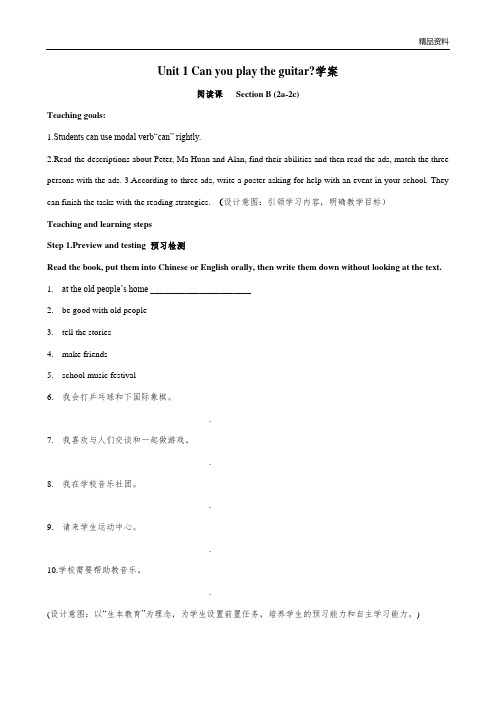
Unit 1 Can you play the guitar?学案阅读课Section B (2a-2c)Teaching goals:1.Students can use modal verb“can” rightly.2.Read the descriptions about Peter, Ma Huan and Alan, find their abilities and then read the ads, match the three persons with the ads.3.According to three ads, write a poster asking for help with an event in your school. They can finish the tasks with the reading strategies. (设计意图:引领学习内容,明确教学目标)Teaching and learning stepsStep 1.Preview and testing 预习检测Read the book, put them into Chinese or English orally, then write them down without looking at the text.1.at the old people’s home _______________________2.be good with old people________________________3.tell the stories___________________4.make friends ____________________5.school music festival_____________6.我会打乒乓球和下国际象棋。
__________________________________.7.我喜欢与人们交谈和一起做游戏。
新目标七年级英语下册Unit 2教案
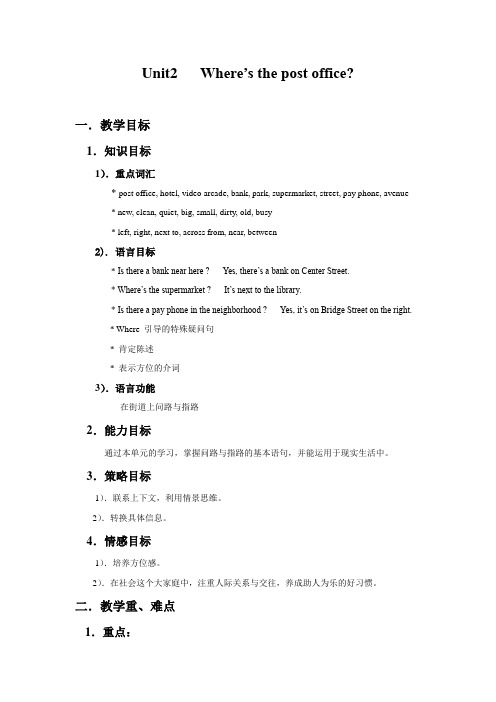
Unit2 Where’s the post office?一.教学目标1.知识目标1).重点词汇* post office, hotel, video arcade, bank, park, supermarket, street, pay phone, avenue* new, clean, quiet, big, small, dirty, old, busy* left, right, next to, across from, near, between2). 语言目标* Is there a bank near here ? Yes, there’s a bank on Center Street.* Where’s the supermarket ? It’s next to the library.* Is there a pay phone in the neighborhood ? Yes, it’s on Bridge Street on the right.* Where 引导的特殊疑问句* 肯定陈述* 表示方位的介词3).语言功能在街道上问路与指路2.能力目标通过本单元的学习,掌握问路与指路的基本语句,并能运用于现实生活中。
3.策略目标1).联系上下文,利用情景思维。
2).转换具体信息。
4.情感目标1).培养方位感。
2).在社会这个大家庭中,注重人际关系与交往,养成助人为乐的好习惯。
二.教学重、难点1.重点:1).表方位的介词:near、across from、next to、between、on2).问路与指路的基本语句2.难点:1).本单元词汇量较大(生词表中列出44个单词,9条短语;课文中还有一些短语)。
2).个别句子有一定难度,如:* Is there a big supermarket near where you live ?* Turn left off the busy First Avenue and enjoy the city’s quiet streets and smallparks.* ┉ there is a small house with an interesting garden.* Bridge Street is a good place to have fun.三.难点注释:* Is there a big supermarket near where you live ?在你住处附近有一家大超市吗?* Turn left off the busy First Avenue and enjoy the city’s quiet streets and smallparks.向左转走出/驶离繁华的第一大道,即可享受到城区里安静的街道和小公园。
五年级下册英语教案 Unit2 Can I help you?Lesson11 人教精通版 (1)
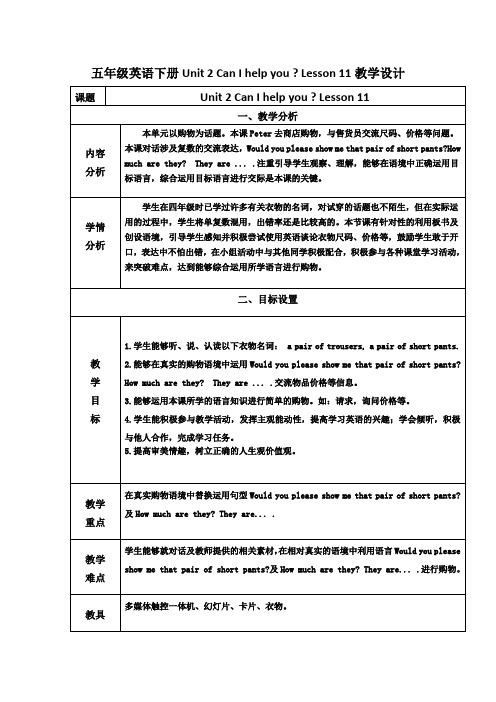
Who wants to have a try?
请完成对话的同学将自己买的衣物图片粘贴到板书上。
教师渗透”Would you please show me that pair of short pants?”
3.教师留住一位售货员同学,继续对话:
(1)
学情
分析
学生在四年级时已学过许多有关衣物的名词,对试穿的话题也不陌生,但在实际运用的过程中,学生将单复数混用,出错率还是比较高的。本节课有针对性的利用板书及创设语境,引导学生感知并积极尝试使用英语谈论衣物尺码、价格等,鼓励学生敢于开口,表达中不怕出错,在小组活动中与其他同学积极配合,积极参与各种课堂学习活动,来突破难点,达到能够综合运用所学语言进行购物。
S;They are shorts.
T: We can also call them”short pants”.
Please read after me.
Short pants,short pants
Please show me a pair of short pants.
2.Look! A clothes shop.
Kate:Oh, It’s too small for me.
Kate:________________?
Saleswoman: Sure , here you are.
Kate:________________ ?
Saleswoman: They’re seven yuan.
S:They are jeans.
T: How about this pair?
They are“trousers”.
Now please read after me.
五年级下册英语说课稿-Unit 2 Can I help you Lesson 10 人教精通版
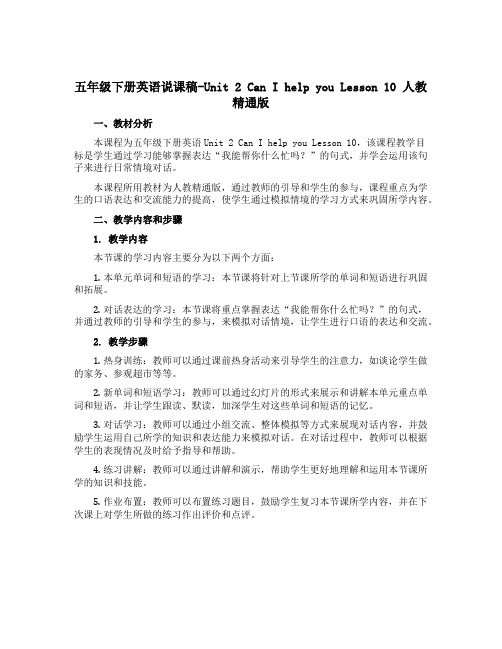
五年级下册英语说课稿-Unit 2 Can I help you Lesson 10 人教精通版一、教材分析本课程为五年级下册英语Unit 2 Can I help you Lesson 10,该课程教学目标是学生通过学习能够掌握表达“我能帮你什么忙吗?”的句式,并学会运用该句子来进行日常情境对话。
本课程所用教材为人教精通版,通过教师的引导和学生的参与,课程重点为学生的口语表达和交流能力的提高,使学生通过模拟情境的学习方式来巩固所学内容。
二、教学内容和步骤1. 教学内容本节课的学习内容主要分为以下两个方面:1.本单元单词和短语的学习:本节课将针对上节课所学的单词和短语进行巩固和拓展。
2.对话表达的学习:本节课将重点掌握表达“我能帮你什么忙吗?”的句式,并通过教师的引导和学生的参与,来模拟对话情境,让学生进行口语的表达和交流。
2. 教学步骤1.热身训练:教师可以通过课前热身活动来引导学生的注意力,如谈论学生做的家务、参观超市等等。
2.新单词和短语学习:教师可以通过幻灯片的形式来展示和讲解本单元重点单词和短语,并让学生跟读、默读,加深学生对这些单词和短语的记忆。
3.对话学习:教师可以通过小组交流、整体模拟等方式来展现对话内容,并鼓励学生运用自己所学的知识和表达能力来模拟对话。
在对话过程中,教师可以根据学生的表现情况及时给予指导和帮助。
4.练习讲解:教师可以通过讲解和演示,帮助学生更好地理解和运用本节课所学的知识和技能。
5.作业布置:教师可以布置练习题目,鼓励学生复习本节课所学内容,并在下次课上对学生所做的练习作出评价和点评。
三、教学方法和策略1. 教学方法1.游戏式教学:教师可以通过卡片游戏等方式,将学习内容转化为游戏,激发学生的兴趣和积极性,从而提高学生的学习效果。
2.交际式教学:通过教师引导学生参与讨论、演示对话等方式,帮助学生充分理解单词和短语的含义和用法,并使学生能够在日常生活中运用所学知识进行交流和表达。
五年级下册英语教案-Unit 2 Can I help you Lesson 11 人教精通版
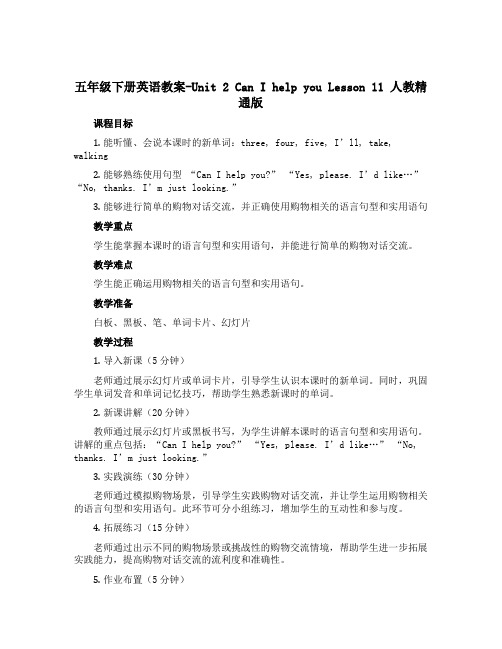
五年级下册英语教案-Unit 2 Can I help you Lesson 11 人教精通版课程目标1.能听懂、会说本课时的新单词:three, four, five, I’ll, take, walking2.能够熟练使用句型“Can I help you?” “Yes, please. I’d like…” “No, thanks. I’m just looking.”3.能够进行简单的购物对话交流,并正确使用购物相关的语言句型和实用语句教学重点学生能掌握本课时的语言句型和实用语句,并能进行简单的购物对话交流。
教学难点学生能正确运用购物相关的语言句型和实用语句。
教学准备白板、黑板、笔、单词卡片、幻灯片教学过程1.导入新课(5分钟)老师通过展示幻灯片或单词卡片,引导学生认识本课时的新单词。
同时,巩固学生单词发音和单词记忆技巧,帮助学生熟悉新课时的单词。
2.新课讲解(20分钟)教师通过展示幻灯片或黑板书写,为学生讲解本课时的语言句型和实用语句。
讲解的重点包括:“Can I help you?” “Yes, please. I’d like…”“No, thanks. I’m just looking.”3.实践演练(30分钟)老师通过模拟购物场景,引导学生实践购物对话交流,并让学生运用购物相关的语言句型和实用语句。
此环节可分小组练习,增加学生的互动性和参与度。
4.拓展练习(15分钟)老师通过出示不同的购物场景或挑战性的购物交流情境,帮助学生进一步拓展实践能力,提高购物对话交流的流利度和准确性。
5.作业布置(5分钟)教师为学生布置相关的作业,包括词组背诵、句型练习和购物对话编写等。
同时,点拨学生注意作业的完成时间和质量,提醒学生认真对待作业,尽快巩固、应用课堂所学知识。
教学评价本课时的教学目标达成情况良好,学生在实践环节中积极参与,购物对话交流流利度和准确性有所提高。
但在语音和语调方面,仍有部分学生需要进一步加强练习,提高自己的语言表达能力。
人教新目标版七年级上册英语教案:Unit 7 SectionB (1a2c) (4)

Unit 7 How much are these socks?SectionA (1a-2e)Teaching aims〔教学目标〕1. 能理解并区别以下单词:much, socks, T-shirt, shorts, sweater, trousers, shoe, skirt, dollar ,big, small, short, long, woman, need, look, pair, take2. 能理解并正确使用以下句型:How much is ?How much are ?Can I help you?Yes, please. I need a sweater forschool.I’ll take it.Here you are.Thank you.You’re welcome.3. 能熟练谈论物品的价格。
学会询问物品的价格 ,谈论衣物的价格。
Language points〔语言点〕1.要求掌握以下句式:-How much is this T-shirt? -It’s seven dollars.-How much are these socks? –They’re two dollars.Can I help you? Yes, please. I need a sweater for school.What color do you want?I’ll take it .Thank you. You’re welcome.2. 要求掌握以下单词:much, socks, T-shirt, shorts, sweater, trousers, shoe,skirt, dollar, big, small, short, long, woman, need, look, pair, take教学重难点谈论物品的价格运用英语语言进行购物。
Teaching steps〔教学步骤〕1. Greetings2. Revision复习以下句型What is this? It’s a ….What color is it? It’s ….What are these? They’re ….What color are they? They’re….为了吸引同学们的注意力 ,加强课堂教学的生动性 ,趣味性 ,提高学习效率 ,这里可以用一些和颜色有关的图片或实物。
五年级下册英语教案 Unit2 Can I help you?(Lesson8) 人教精通版
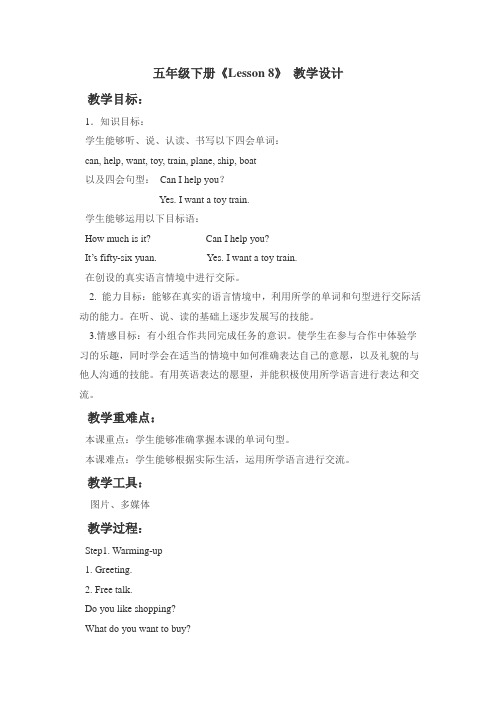
五年级下册《Lesson 8》教学设计教学目标:1.知识目标:学生能够听、说、认读、书写以下四会单词:can, help, want, toy, train, plane, ship, boat以及四会句型:Can I help you?Yes. I want a toy train.学生能够运用以下目标语:How much is it? Can I help you?It’s fifty-six yuan. Yes. I want a toy train.在创设的真实语言情境中进行交际。
2. 能力目标:能够在真实的语言情境中,利用所学的单词和句型进行交际活动的能力。
在听、说、读的基础上逐步发展写的技能。
3.情感目标:有小组合作共同完成任务的意识。
使学生在参与合作中体验学习的乐趣,同时学会在适当的情境中如何准确表达自己的意愿,以及礼貌的与他人沟通的技能。
有用英语表达的愿望,并能积极使用所学语言进行表达和交流。
教学重难点:本课重点:学生能够准确掌握本课的单词句型。
本课难点:学生能够根据实际生活,运用所学语言进行交流。
教学工具:图片、多媒体教学过程:Step1. Warming-up1. Greeting.2. Free talk.Do you like shopping?What do you want to buy?Which toy do you like?(通过此环节让学生在自然而然中进入到英语学习的状态中来,同时也为本课的新知做好铺垫。
)教学参考时间:3-5分钟Step2. Presentation1. Listen to the dialogue and then answer these two questions :What does the saleswoman say?What’s in the shop?(本课是单词句型操练课,但简单的讲解操练会让孩子们失去学习的热情,所以结合第七课的对话,把本课的单词、句型以对话的形式呈现出来,形式新颖,也能提高学生的学习兴趣,在第一遍听的过程中解决本课中一部分四会单词句型,不但将难点逐一解决,也让学生在情境中习到了语言。
人教版新目标七年级英语上册unit7单元教案

Unit 7 How much are these socks?教材解读该单元的主题是shopping,单词主要是关于各种衣服、表示颜色的词以及部分表示数字的词。
通过大量反复的对话练习,掌握如何询问价格、谈论衣服、提供帮助、表示感谢。
学习方式涉及听说读写各个方面。
通过大量的对话以及结队活动、小组活动等任务型活动,让学生在重复模仿中学会对话,进行简单的分角色表演,在完成任务中完成语言学习任务。
语法部分主要是询问价格以及回答。
单元目标一、知识与技能1. 掌握词汇:socks、T-shirt、pants、shoes、shorts、sweater、bag、dollar、black、small、short、long、black、white、red、green、blue、big、numbers 10~31和指示代词this、that、these、those。
2. 掌握句型:How much is this T-shirt? It’s seven dollars.How much are these socks? They’r e two dollars.You’re welcome.二、过程与方法通过对“购物”的讨论与学习,认识各种衣物,学会询问衣物的价格和答语。
学会提供帮助并对别人的帮助表示感谢。
能听懂关于购物的对话,能理解关于购物的短文,全面提高听说读写综合能力。
三、情感态度与价值观1. 学会询问价格并回答。
2. 培养学生在购物方面对价格的感知。
能认识到衣物有价格的高低,但没有好坏之分,不管我们的衣服值多少钱,只要大方得体、干净整洁,就是好衣服。
教法导航1. 利用图片和视频调动学生的兴趣和积极性,帮助学生直观清楚地认识各种衣物。
2. 将学生分为小组活动,教师指导小组成员完成教学任务。
3. 指导学生通过大量练习,由浅入深逐步掌握重点词汇及语法知识。
4. 听录音,指导学生完成相关练习,同时指导学生完成小对话,正确表达询问价格,回答,提供帮助,感谢他人。
五年级下册英语教学设计-Unit 2 Can I help you Lesson 9 |人教精通版

五年级下册英语教学设计-Unit 2 Can I help you Lesson 9 |
人教精通版
教学目标
1.学习如何提供帮助和接受帮助的表达方式
2.可以流利地使用对话中的表达方式,进行实际场景的表达
教学重点
1.学习如何用简单的英语表达需要帮助
2.学习如何用英语表达提供帮助的方式
教学难点
1.学生如何在实际生活中运用所学的知识
2.学生如何在教师引导下自主地运用所学的知识
3.学生如何将所学知识与自己的生活经验相连结,形成有意义的知识
教学过程
1. 介绍和复习
教师首先介绍本节课将要学习的内容和目标,然后以回顾上节课的方式进行复习。
教师可以向学生提问上节课学到的内容,并鼓励他们回答问题。
2. 新知
1.教师与学生进行对话,模拟日常生活场景,如:
教师:Can I help you?
学生:Yes, please. I’m looking for a book.
教师:What kind of book are you looking for?
学生:I’m looking for a storybook.
2.教师让学生看对话中的关键单词,如:book, storybook, help 等,并解释这些单词的含义。
3.教师然后向学生介绍。
Unit2 Can I help you?(Lesson7) (公开课)教案 (1)
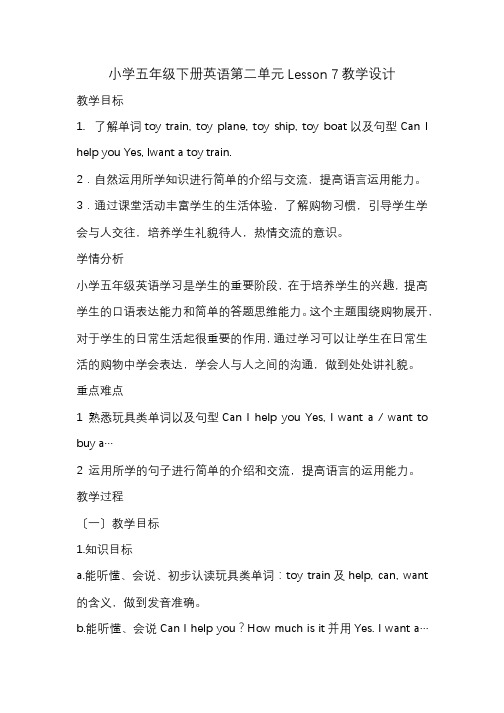
小学五年级下册英语第二单元Lesson 7教学设计教学目标1. 了解单词toy train, toy plane, toy ship, toy boat以及句型Can I help you Yes, Iwant a toy train.2.自然运用所学知识进行简单的介绍与交流,提高语言运用能力。
3.通过课堂活动丰富学生的生活体验,了解购物习惯,引导学生学会与人交往,培养学生礼貌待人,热情交流的意识。
学情分析小学五年级英语学习是学生的重要阶段,在于培养学生的兴趣,提高学生的口语表达能力和简单的答题思维能力。
这个主题围绕购物展开,对于学生的日常生活起很重要的作用,通过学习可以让学生在日常生活的购物中学会表达,学会人与人之间的沟通,做到处处讲礼貌。
重点难点1 熟悉玩具类单词以及句型Can I help you Yes, I want a / want to buy a…2 运用所学的句子进行简单的介绍和交流,提高语言的运用能力。
教学过程〔一〕教学目标1.知识目标a.能听懂、会说、初步认读玩具类单词:toy train及help, can, want 的含义,做到发音准确。
b.能听懂、会说Can I help you?How much is it并用Yes. I want a…及It’s…yuan.作出答复。
2.能力目标a.能在实际生活中运用英语表达熟悉和喜爱的玩具。
b.培养学生根据情景正确运用语言的能力。
3.情感态度目标a.在活动中培养学生的协作精神。
b.培养学生认真、积极、大胆的学习态度。
〔二〕教学重点能听懂、会说、初步认读玩具类单词:toy train及help, can, want的含义,提高学生对单词的听、说、认、读能力。
〔三〕学时难点能听懂、会说Can I help you?How much is it 并用Yes. I want a…及It’s…yuan.作出答复。
通过活动复习稳固本单元的重点句型,让学生能灵活的运用所学的句型进话。
unit 2 How often do you exercise 全单元教案 (5课时)
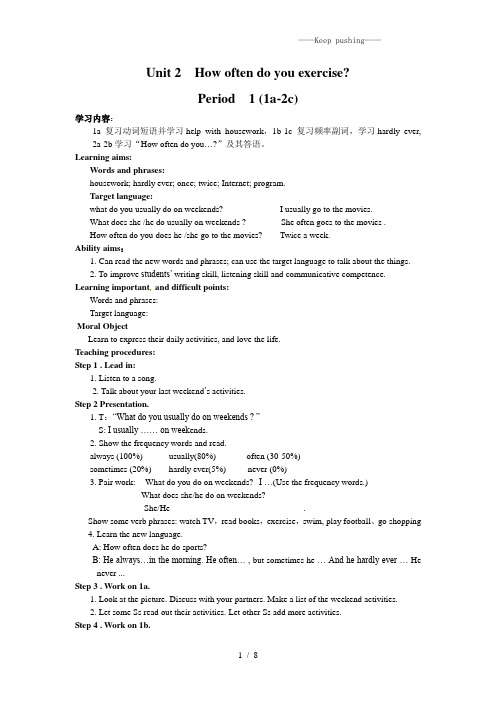
Unit 2 How often do you exercise?Period 1 (1a-2c)学习内容:1a 复习动词短语并学习help with housework,1b-1c 复习频率副词,学习hardly ever, 2a-2b学习“How often do you…?”及其答语。
Learning aims:Words and phrases:housework; hardly ever; once; twice; Internet; program.Target language:what do you usually do on weekends? I usually go to the movies.What does she /he do usually on weekends ? She often goes to the movies .How often do you does he /she go to the movies? Twice a week.Ability aims:1. Can read the new words and phrases; can use the target language to talk about the things.2. To improve students’ writing skill, listening skill and communicative competence. Learning important and difficult points:Words and phrases:Target language:Moral ObjectLearn to express their daily activities, and love the life.Teaching procedures:Step 1 . Lead in:1. Listen to a song.2. Talk about your last weekend’s activities.Step 2 Presentation.1. T:“What do you usually do on weekends ? ”S: I usually …… on week ends.2. Show the frequency words and read.always (100%) usually(80%) often (30-50%)sometimes (20%) hardly ever(5%) never (0%)3. Pair work: -- What do you do on weekends?--I …(Use the frequency words.)--What does she/he do on weekends?-- She/He ___________ _________________.Show some verb phrases: watch TV,read books,exercise,swim, play football、go shopping4. Learn the new language.A: How often does he do sports?B: He always…in the morning.He often… , but sometimes he … And he hardly ever … He never ...Step 3 . Work on 1a.1. Look at the picture. Discuss with your partners. Make a list of the weekend activities.2. Let some Ss read out their activities. Let other Ss add more activities.Step 4 . Work on 1b.1. Let a student read the words aloud. Make sure all the Ss know the meaning of the words.2. Tell Ss to listen and write the letters from the picture above on the line below.3. Play the tape for the first time. Ss listen and fill in the blanks.4. Play the tape for the second time for the Ss to check the answers.Step 5. Pair work.1. Act out the conversation with a student.2. Let Ss talk about the pictures in 1a in pairs.3. Let some Ss act out their conversations.Step 6 Learn the new language.Show the pictures and ask and answer: How often do you exercise?--Twice a week.Step 7. Work on 2a:1. Let Ss read the phrases in the chart.2. Tell Ss that Cheng Tao is taking about how often he does these activities. Play the recording for the first time. Ss listen and number the activities [1-5].3. Play the recording for the second time for the Ss to check the answers.Step 8.Work on 2b:1. Tell Ss they will hear the recording again. This time, listen and match the activities in 2a with how often Cheng Tao does them.2. Ss listen and math the activities with the phrases.3. Check the answers.Step 9. Pair work.1. Ask one student how often he/she watch TV as a model.T: Hi, S1. How often do you watch TV? S1: I watch TV every day.T: What’s your f avorite program? S1: Animal world.T: How often do you watch it? S1: Twice a week.2. Let one student read the activities in the chart. Tell them these new words:favorite website (最喜欢的网站);favorite sport (最喜欢的运动)3. Ss work with their partners. Then ask some pairs to act out their conversations.Step 10. Writing.According to the conversation, write about how often your partner do the activities.Example: ×× is a Middle School student. He reads English twice a week. He watches TV every day. He goes to the movies once a month, and he exercises three times a week. But he hardly ever uses the Internet.Step 11 Summarize. Unit 2 How often do you exercise? What do you usually do on weekends? I usually go to the movies. What does she /he do usually on weekends ? She often goes to the movies . How often do you does he /she go to the movies? Twice a week.always 100% usually 80% often 30-50% sometimes 20% hardly ever 5% never 0%Period 2 (2d-3c)Learning aims:Words and phrases:full, swing, swing dance, maybe, least, at leastTarget language:—How often do you /does he(she)….? —He usually…The use of the frequency words: always; usually ; often ; sometimes; hardly ever; never Ability aims:1. Can read the new words and phrases; can use the target language to talk about the things.2. To improve students’ writing skill, listening skill and communicative competence. Learning important and difficult points:Words and phrases and target language:Moral ObjectLearn to express their daily activities, and love the life.Teaching procedures:Step 1 Review:1.Show a subject schedule, ask and answer:How often do you have _________ class? --We have _________class ____________.Step 2 Work on 2d.1. Lead in: Show some pictures and practice:A: What does she usually do? --B: She usually has piano lessons.A: How often does she have piano lessons? --B: She has piano lessons twice a week.2. show a video, and ask : What dance? –swing dance.Claire are having dance and piano lessons. Let’s listen to her and Jack’s conversation, listen and answer:3. Read the conversation and match the activity with the right time.4. Follow the tape and then Role-play the conversation.Step 3 Grammar focus:1. Practice: show the pictures and the pie charts, ask and answer:T: How often does he play soccer ? The other Ss: He plays soccer twice a week2. read grammar focus and give some explanations.Step 4 Work on 3a.Complete the questions with do or does. Then match the questions and answers.Step 5 Work on 3b.1. Tell Ss to make questions.2. Then try to ask and answer questions about the questions.3. Ask some Ss to ask and answer with their partners in front of the class.Step 6 Work on 3c.1. Let Ss work in groups of six or e ight.2. Tell Ss discuss what activities they do to improve their English. Then write the activities inthe chart.3. Ask their group mates the questions and fill in the chart.4. Try to make a report about their partners.Period 3 Section B (1a-1e)Learning aims:Words and phrases:Learn to use “junk, junk food, coffee, health, drink coffee, be good for”Target language:what do you usually do on weekends?I usually go to the movies.What does she /he do usually on weekends ?She often goes to the movies .How often do you does he /she go to the movies?Twice a week.Ability aims:1. Can read the new words and phrases;2. can use the target language to talk about how often you do things.3. ask people about their healthy habits and express themselves4. To improve students’ writing skill, listening skill and communicative competence. Learning important and difficult points:Words and phrases and target language.Moral ObjectLearn how to arrange the life, to develop good habits.Teaching procedures:Step 1 .Warming up and leading in:1. T: Hello, everyone! Do you like music? Now let’s listen to Do You Like….If you can sing the song, you can sing it together. Listen carefully, then who can say thenames of the food or drink ?Play the video.2. Some foods are healthy foods, some are not. Write “healthy food ; unhealthy food(junkfood)” Say the healthy food and junk food.3. Students draw the pictures of the food that they like. Then students say“I like… becauseit/they”“I I like… although it/they…”Step 2 Pair work.1. Let’s ask about how often you eat food.example: A: How often do you drink milk?B: I drink milk every day.A: Do you like it?B: No. But my mother wants me to drink it. She says it’s good for my health.2. Students work.Step 3 Work on 1a.T:Now open your books and turn to page 12. Look at 1a, match the words with the pictures.( Students match them.)Step 4 .Work on 1c.1. T: Eating healthy food can help us to keep healthy. It’s a good habit. What are the goodhabits for your health. Exercise; sleep2. Listen for the general idea of 1c.T: Next we’ll listen to a conversation between Tina and Bill.First let’s listen for the general idea.Students listen and give their answers.3. Listen for the specific ideas of 1c .T: Listen carefully again and Circle the answer to each question.4. Check the Ss’ answers.Step 5. Work on 1d.1. T: Now look at the questions in 1d . Fill in the blanks in the survey.2. Play the first time, you can just listen.Play the tape for the second time ,you can listen and find the answers.3. Check the answers.4. Listen and repeat. T: I’ll play the recording again. You’ll repeat it after the tape.Step 6. Pair work.Role play. Student A is the reporter. Student B is Tina or Bill. Try to act the conversationout .They can use their own words.Example: A: How often do you exercise?B: I exercise every day.A: And how often do you …?Step 7. Take the health quiz.(p16)Step 8. Summarize.T: And you know: Healthy lifestyle can help us get good grades. Good food and exercise help us to study better. Look at saying.Period 4 section B (2a-2e)Step 1 . Warming- up and revision1. Daily greeting.2. Let some Ss report what he/she does on weekends.Step 2 Work on 2a.1. Let Ss discuss the activities with their classmates and rank these activities according to howoften you think your classmates do them.2. Let some Ss tell their answers.S tep 3 . Work on 2b.1. T: Here are the results of what the students in No. 5 High School do in their free time. Readthe passage quickly and find the answers to the two questions:1) How many kinds of free time activities are mentioned in the passage?2) What is the best way to relax? _________________________________2. Read the passage carefully and complete the pie chart below.Ss read the passage and try to fill in the pie chart. Then check the answers together.Step 4 Work on 2c.1. T: Now let’s read through the five questions. Make sure the Ss know the meaning of thequestions. Then le t Ss read the passage again and try to find the answers to the questions.2. Ss read carefully and try to find the answers to the questions.3. Check the answers with th e class.Step 5 Work on 2d.1. T: Now let’s make some sentences with the percentages using al ways, usually orsometimes.2. Ss read the passage again and try to make some new sentences. Check the answers witheach others.Step 6 Work on 2e.1. Let Ss read through the activities in the chart first. Select one activity from them. Then asktheir classmates how often they do this activity and make a pie chart.2. Ss work in groups. Ask and answer questions then fill in the chart.3. Make a pie chart like those in 2b.4. The n try to make a short report like the report in 2b.Step 7. HomeworkPeriod 5 Section B (3a-self check)Step 1 . Warming- up and revision.1. Have a dictation of the new words and expressions.2. Let some Ss read the passage in 2b.3. Check the homework.Step 2 . Presentation.1. Show some pictures of your daily activities. Tell Ss your good activities and badactivities.2. Let some Ss tell about how often they do some activities and judge they are good habits andbad habits.Step 3. Practice –work on 3a.1. Look at the information in the chart and complete the report.2. Ss read the passage then fill in the blanks with the words in the box.3. . Check the answers.Step 4. Writing--work on 3b.1. Complete the chart with your own information. Then in the last column, use expressionslike always, every day, twice a week and never.2. Then let some Ss show their chart to the class.Step 5 Work on 3c.1. Let Ss write a report about their good habits and bad habits. Say how often they do thingsusing the report in 3a as an example.2. Students write.3. Check the compositions and let some Ss read their compositions.Step 6 Self Check 1 and 2.1. Students discuss.2. Let some Ss read aloud their chart. Then try to write five sentences using the informationabove.3. Make sure they use the correct forms of the verbs.Step 7 Self check 3.1. Tell Ss that they should read the conversation and then fill in the blanks with the rightforms.2. Ss read the conversations and try to fill in the blanks.3. Check the answers:usually, How often, Hardly, How often, once a; never4. Let Ss practice the conversation with their partner.Step 8. Homework.1. Review Section B.2. Write a short passage your father or m other’s good habits or bad habits.教师的职务是‘千教万教,教人求真’;学生的职务是‘千学万学,学做真人’。
Unit7 SectionB 教案2021-2022学年人教版英语九年级全册

Unit 7Teenagers should be allowed to choosetheir own clothes.Section B (2a—2e)一、教学目标1. 掌握下列重点词汇及短语:support, enter, choice, get in the way of, be serious about2. 掌握重点句型:What is your dream job?Do your parents support your dream?But sometimes these can get in the way of their schoolwork, and parents might worry about their success at school.I think I should be allowed to make this choice myself.Only then will I have a chance to achieve my dream.3. 能够读懂有关梦想的阅读材料,同时能够使用“在用中学”的学习策略完成阅读任务。
4. 能够使用目标语言谈论家庭制度,自己的梦想以及父母对自己梦想的支撑。
5. 能够使用情态动词和含情态动词的被动语态表达自己对事情的看法和观点。
6. 培养学生自我判断是非的能力,作为学生什么该做,什么不该做,要做到心中有数。
二、教学重点及难点重点:1. 掌握本课时重点词汇、短语和句型表达。
2. 能够使用“在用中学”的学习策略完成阅读任务。
难点:1. 使用目标语言谈论家庭制度,自己的梦想以及父母对自己梦想的支撑。
2. 使用情态动词和含情态动词的被动语态表达自己对事情的看法和观点。
三、教学准备教师:教学课件;多媒体设备学生:课前预习四、教学过程Step 1 RevisionPractice and review the grammar.【设计意图】通过含情态动词的被动语态的互动练习,检测学生上节课语法知识的掌握情况。
五年级下册英语教案-Unit 2 Can I help you Lesson 7 人教精通版
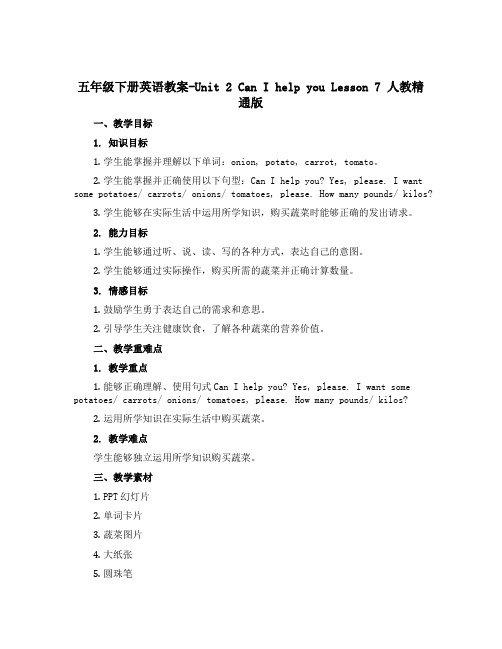
五年级下册英语教案-Unit 2 Can I help you Lesson 7 人教精通版一、教学目标1. 知识目标1.学生能掌握并理解以下单词:onion, potato, carrot, tomato。
2.学生能掌握并正确使用以下句型:Can I help you? Yes, please. I want some potatoes/ carrots/ onions/ tomatoes, please. How many pounds/ kilos?3.学生能够在实际生活中运用所学知识,购买蔬菜时能够正确的发出请求。
2. 能力目标1.学生能够通过听、说、读、写的各种方式,表达自己的意图。
2.学生能够通过实际操作,购买所需的蔬菜并正确计算数量。
3. 情感目标1.鼓励学生勇于表达自己的需求和意思。
2.引导学生关注健康饮食,了解各种蔬菜的营养价值。
二、教学重难点1. 教学重点1.能够正确理解、使用句式Can I help you? Yes, please. I want some potatoes/ carrots/ onions/ tomatoes, please. How many pounds/ kilos?2.运用所学知识在实际生活中购买蔬菜。
2. 教学难点学生能够独立运用所学知识购买蔬菜。
三、教学素材1.PPT幻灯片2.单词卡片3.蔬菜图片4.大纸张5.圆珠笔1. 导入1.引导学生回忆上节课所学知识,利用图片卡片让学生自由搭配与蔬菜有关的英文单词,进行记忆复习。
2. 新课讲解1.呈现PPT,介绍本节课的话题-shopping for vegetables.2.面向学生,先让学生了解小贩卖菜的背景。
讲授要买四种蔬菜,分别是onion, potato, carrot, tomato。
3.给学生发放纸张,让学生写下自己所需请中蔬菜(至少一个种)。
这一步目的是训练学生口语表达能力和意向表达能力。
PEP小学英语四年级上册unit5B 教学设计
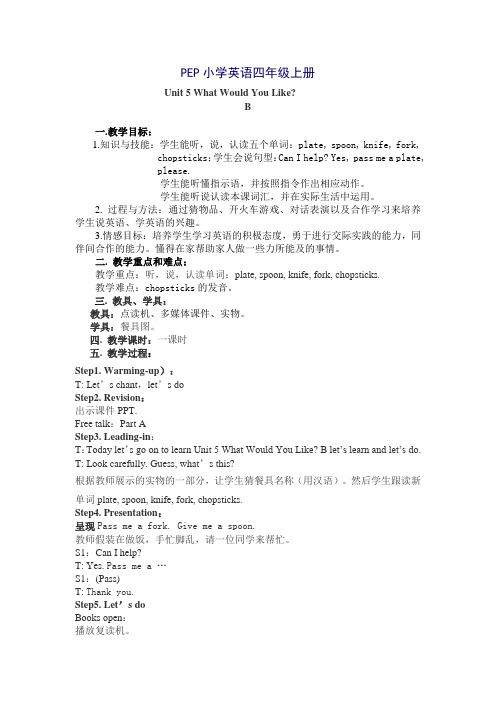
PEP小学英语四年级上册Unit 5 What Would You Like?B一.教学目标:1.知识与技能:学生能听,说,认读五个单词:plate, spoon, knife, fork,chopsticks;学生会说句型:Can I help? Yes, pass me a plate,please.学生能听懂指示语,并按照指令作出相应动作。
学生能听说认读本课词汇,并在实际生活中运用。
2. 过程与方法:通过猜物品、开火车游戏、对话表演以及合作学习来培养学生说英语、学英语的兴趣。
3.情感目标:培养学生学习英语的积极态度,勇于进行交际实践的能力,同伴间合作的能力。
懂得在家帮助家人做一些力所能及的事情。
二. 教学重点和难点:教学重点:听,说,认读单词:plate, spoon, knife, fork, chopsticks.教学难点:chopsticks的发音。
三. 教具、学具:教具:点读机、多媒体课件、实物。
学具:餐具图。
四. 教学课时:一课时五. 教学过程:Step1. Warming-up):T: Let’s chant,let’s doStep2. Revision:出示课件PPT.Free talk:Part AStep3. Leading-in:T:Today let’s go on to learn Unit 5 What Would You Like? B let’s learn and let’s do. T: Look carefully. Guess, what’s this?根据教师展示的实物的一部分,让学生猜餐具名称(用汉语)。
然后学生跟读新单词plate, spoon, knife, fork, chopsticks.Step4. Presentation:呈现Pass me a fork. Give me a spoon.教师假装在做饭,手忙脚乱,请一位同学来帮忙。
小学英语《Unit 5 Lesson 1 Can I help you 》优质课教学设计、教案

Unit5 Lesson1 Can I help you ? 教学设计Step 1 .Greeting and leading inT: This is a song about shopping. In supermarket ,we can buy lots of things . Let’s look and say. We can buy .(课件播放vegetables , fruit ,pens,shoes, clothes ,basketballs...图片,学生快速读出单词,并出示玩具的图片教授新词汇toy )T:So many different things we can buy , I’d like a pen, please .What about you ? 学生借助图片进行I’d like...句型的复习与铺垫,教师及时进行评价,为拓展环节做对话铺垫。
Step2 .Text and words learning出示课文第一幅图片T: Who are they ? Li Ming and Mum are shopping ,too . 课件出示李明和妈妈在超市的场景,What’s in the shop ? Pens , rulers , books and toys ...What does Li Ming want to buy ?1)Let’s watch the video and get more information.What does Li Ming want to buy ?播放课文视频第一遍, 整体感知课文。
T:OK, that’s all. What does Li Ming want to buy ?S: ToysT: Yes. Now let’s listen , Li Ming says (播放音频“ Mum ,May I have a toy ?”)学生听音后齐读句子。
译林版英语四年级上册第7单元教案

译林版英语四年级上册第七单元教学要求
译林版英语四年级上册第七单元教学设计方案 NO:1
译林版英语四年级上册第七单元教学设计方案 NO:2
译林版英语四年级上册第七单元教学设计方案 NO:3
译林版英语四年级上册第七单元教学设计方案 NO:4
译林版英语四年级上册第七单元教学设计方案 NO:5
译林版英语四年级上册第七单元教学设计方案 NO:6
译林版英语四年级上册第七单元教学设计方案 NO:7
译林版英语四年级上册第七单元教学设计方案 NO:8。
(小学六年级英语教案)Unit 5 Can I help you--探究活动-教学教案
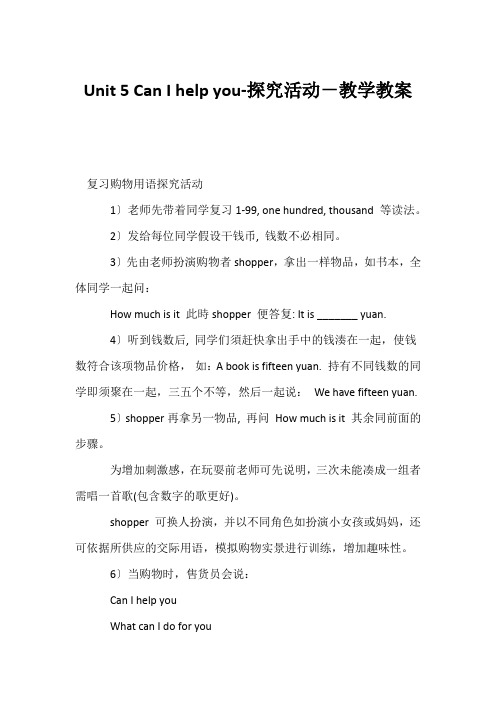
Unit 5 Can I help you-探究活动-教学教案复习购物用语探究活动1〕老师先带着同学复习1-99, one hundred, thousand 等读法。
2〕发给每位同学假设干钱币, 钱数不必相同。
3〕先由老师扮演购物者shopper,拿出一样物品,如书本,全体同学一起问:How much is it 此時shopper 便答复: It is _______ yuan.4〕听到钱数后, 同学们須赶快拿出手中的钱湊在一起,使钱数符合该项物品价格,如:A book is fifteen yuan. 持有不同钱数的同学即须聚在一起,三五个不等,然后一起说:We have fifteen yuan.5〕shopper再拿另一物品, 再问How much is it 其余同前面的步骤。
为增加刺激感,在玩耍前老师可先说明,三次未能凑成一组者需唱一首歌(包含数字的歌更好)。
shopper 可换人扮演,并以不同角色如扮演小女孩或妈妈,还可依据所供应的交际用语,模拟购物实景进行训练,增加趣味性。
6〕当购物时,售货员会说:Can I help youWhat can I do for youWhat colour do you wantWhat size do you wantHow about a blue oneWhat about that one7) 购物者会说:I want a book/dress/coat.How much is itYes, I like it.玩具交易市场探究活动同学家里肯定会有一些还很新,但却不太爱玩的玩具或是还没有用的文具,可以让孩子选择其中一两件,拿到来交换。
老师提前让孩子带一些零用钱来,依据本班同学的家庭条件,老师可以限定交易金额以一元、三元或五元为限。
让孩子自己进行交易,买自己宠爱的文具或玩具,或卖出自己闲置不用的东西,在实际交易中稳固,运用所学学问。
在活动中,老师要巡察,辅导,要求同学用英语进行沟通,不要使用中文。
人教精通版五年级英语下册 Unit 2 Can I help you Lesson 9 教案
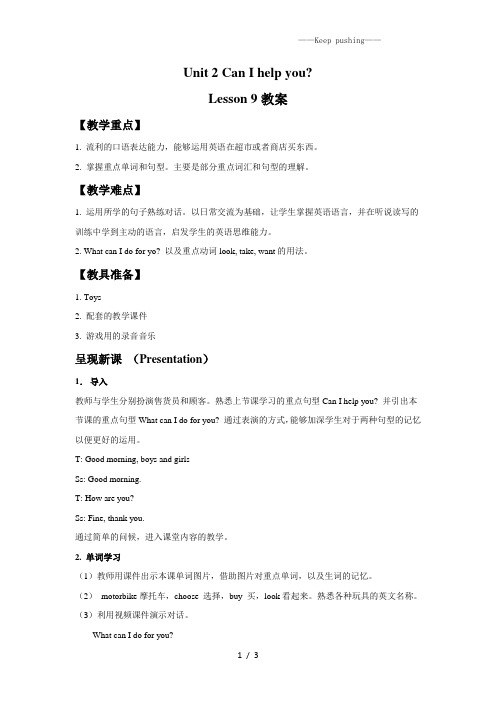
Unit 2 Can I help you?Lesson 9教案【教学重点】1. 流利的口语表达能力,能够运用英语在超市或者商店买东西。
2. 掌握重点单词和句型。
主要是部分重点词汇和句型的理解。
【教学难点】1. 运用所学的句子熟练对话。
以日常交流为基础,让学生掌握英语语言,并在听说读写的训练中学到主动的语言,启发学生的英语思维能力。
2. What can I do for yo? 以及重点动词look, take, want的用法。
【教具准备】1. Toys2. 配套的教学课件3. 游戏用的录音音乐呈现新课(Presentation)1.导入教师与学生分别扮演售货员和顾客。
熟悉上节课学习的重点句型Can I help you?并引出本节课的重点句型What can I do for you?通过表演的方式,能够加深学生对于两种句型的记忆以便更好的运用。
T: Good morning, boys and girlsSs: Good morning.T: How are you?Ss: Fine, thank you.通过简单的问候,进入课堂内容的教学。
2. 单词学习(1)教师用课件出示本课单词图片,借助图片对重点单词,以及生词的记忆。
(2)motorbike摩托车,choose 选择,buy 买,look看起来。
熟悉各种玩具的英文名称。
(3)利用视频课件演示对话。
- What can I do for you?- I want to buy a toy plane.(重点介绍want to do sth. 和want sth. )- Choose one you like. (Which one do you like?)- How about this one? (How about 重点介绍)- It looks nice. (look的三单形式引入。
)(4)让学生跟练熟悉上口。
(5)领读两遍。
- 1、下载文档前请自行甄别文档内容的完整性,平台不提供额外的编辑、内容补充、找答案等附加服务。
- 2、"仅部分预览"的文档,不可在线预览部分如存在完整性等问题,可反馈申请退款(可完整预览的文档不适用该条件!)。
- 3、如文档侵犯您的权益,请联系客服反馈,我们会尽快为您处理(人工客服工作时间:9:00-18:30)。
(2)鼓励学有余力的学生学习其他的打招呼用语。
对课文情境模仿以及演练,成了英语课教学中一个很好的手段,可以让学生调节学习气氛,还可以让学生在放松的状态下学习巩固,又能让很多学生参与进来,达到锻炼的目的。所以这样的设计环节可以说成了英语教学中必不可少的一笔了。
S:It `s a jacket./…….
……
2、让学生自己介绍自己的衣服。
(示范) Look at my shirt.it`s red.……
B、Learn to say
示情境图,让学生了解图里的人物,以及他们在做什么事?
1)放录音
学生听后,让学生根据图意,猜猜里面的对话会是什么内容?
帮助理解句子的意思。
学生表演:S: Look at my… S:Oh it`s very nice.
C、Say a rhyme
1、教学zip
2、示情境图,让学生看图;
3、然后带领学生读熟句子。
Then listen to the tape,read after it .
指导学生的诵读的节奏和词语发音。
D、Assign homework
T :Look around the class, how many students in yellow clothes?
S : One, two, …..
2、教师准备一些服装或图片,从复习学过的单词入手,学习新的单词。
T: (指着学生的衣服问) what`s this?
S: It`s a coat.(跟读几遍)
Unit7 Can I help you?
——Can I help you?
——I `பைடு நூலகம் like a jacket .
a dress
a shirt
a blouse
小学外语备课用笺
教学过程:
A. Free talk:
1、(教师可以利用图片或学生身上的衣服进行交流)
T:Look at ***`s clothes,do you know what`s this ?
1、复习数数
T: Hello, boys and girls. How are you?
S : Fine, thank you? And you ?
T : Fine ,thanks .
Look at *** `s clothes. What colour is it ?
S : It`s yellow.
T: Can I help you?
S1:I `d like….
S1: Can I help you?
S2:I `d like….
教学随笔
小学外语备课用笺
教学过程:
S2: Can I help you?
……
教师对表现出色的学生进行鼓励。
D: Say a rhyme
组织学生开展说歌谣比赛。
E、Assign homework
教学jacket,注意纠正学生的发音。帮助记忆,让学生想这种衣服的中文“茄克衫”,有谐音,比较好记。
2、T:(出示shirt) It`s a shirt.
教学生词,学生跟读。
教学随笔
小学外语备课用笺
教学过程:
同上教学dress, blouse.
3、listen to the tape, then read after it.
T: What`s this?
S : It`s a sweater.(同上)
T: Is it a coat?
S : No, it `s a T-shirt.
T :(示图)What`s this?
S : It `s a skirt.(同上)
B、Look and learn
1、T:(指着学生的jacket)Do you know what`s this?
2)教学句子:can I help you?
I `d like….
3)让学生分角色朗读课文。
C: Practise
1)组织学生开展“超级模仿秀”活动,模仿课文中的情境进行交流活动。
给学生一些时间充分准备后,指名几组进行表演,并进行评比。
2)组织学生进行“招聘营业员”活动,教师在教室前布置一个小商店,(放置一些文具、食品或衣服等其他物品),让学生轮流上前进行面试考核。
2、会说歌谣Zip,zip, zip.
教具准备及辅助活动:
录音机、词语卡片、挂图
作业设计安排:
课内:同桌互读朗读B部分
课外:朗读B、C部分至熟练
主要板书计划
Unit7 Can I help you?
a jacket
a dress
a shirt
a blouse
小学外语备课用笺
教学过程:
A. Free talk:
4、游戏巩固——“找一找,贴一贴”
准备好单词纸条和衣服图片,然后组织学生开展游戏。
5、what`s missing
师很快的拿走其中的一个,让学生猜是什么?看谁记忆好。
6、漂亮show
让学生穿上自己准备好的漂亮服装,上台模仿show,进行表演。
示范:T: (做动作)Look at my jacket. Ss:Oh , it`s nice.
小学外语备课用笺
课题
Unit7 Can I help you?
第1课时
总第19课时
教学目标:
1、能听懂、会说、初步认读jacket,dress,shirt,blouse,发音准确。
2、会说歌谣Zip,zip, zip.
教学重点难点:
1、能听懂、会说、初步认读jacket,dress,shirt,blouse,发音准确。
教学随笔
小学外语备课用笺
课题
Unit7 Can I help you?
第2课时
总第20课时
教学目标:
1、能听懂并会用can I help you?向顾客打招呼,并会用I `d like….作回答。
2、能熟练认读单词jacket,dress,shirt,blouse,发音准确。
2、会说歌谣Zip,zip, zip.
(1)听录音,读熟B部分单词。
(2)鼓励学生平时用所学的日常交际用语相互打招呼。
本课中的4个单词,有两个应该比较好记,jacket和中文有谐音,shirt可以借助T-shirt来记,这样只剩下两个单词,应该说是降低了一些难度了。为了让学生能有进一步的掌握和巩固,本课中还设计了“时装show”,让学生在show的过程中边演边说,愉乐中掌握。
教学重点难点:
1、能听懂并会用can I help you?向顾客打招呼,并会用I `d like….作回答。
2、能熟练认读单词jacket,dress,shirt,blouse,发音准确。
教具准备及辅助活动:
录音机、词语卡片、挂图
作业设计安排:
课内:同桌互读A部分
课外:听、读A部分至熟练
主要板书计划
